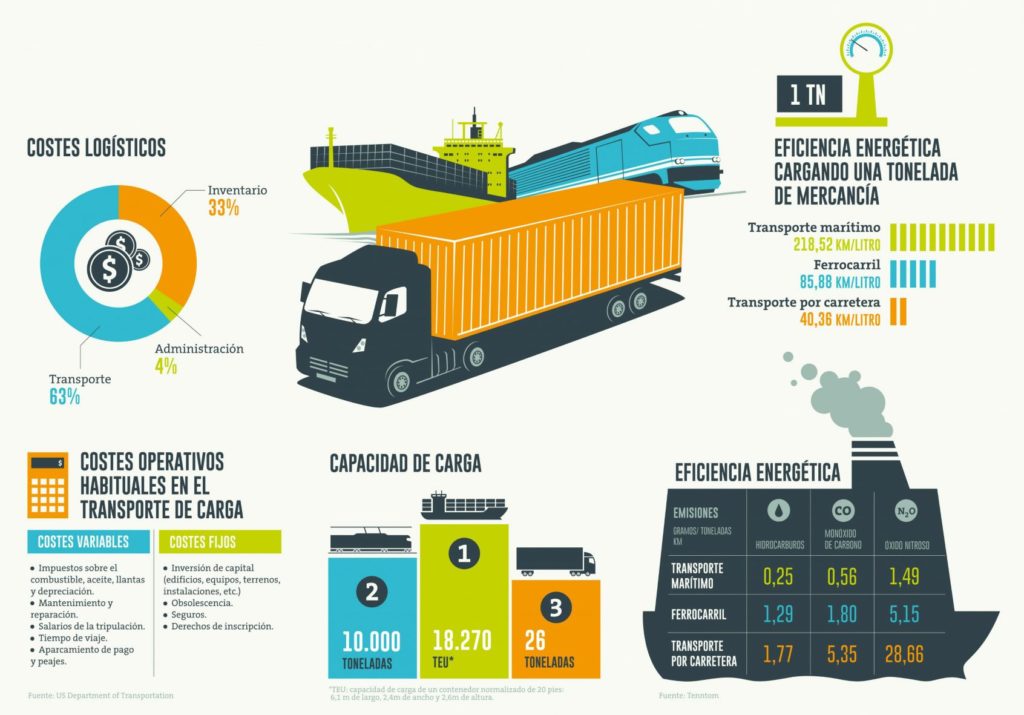Growing globalization and momentum from innovative tools are transforming merchandise transport, an area developing into increasingly complex systems that come together under the umbrella concept of logistics. Intermodal transportation is having an especially outsized impact on the field of logistics as the most efficient and competitive option for managing international transactions.
transported in at least two different vehicles. Intermodal transportation also involves always maintaining the same loading unit (containers, semi-trailers, or swap bodies), without loading or unloading during transfers between modes.
In short, the many advantages offered by different logistics types continues “to optimize the different flows, both physical and data flows, that go along with moving merchandise,” said Alberto Palacios, technical director of the Centre for Transportation Studies for the Western Mediterranean (CETMO). This will lead to a reduction in handling costs, an increase in transaction speed, greater access to equipment, and standardized transit hours.
This type of logistics is already here, as leveraging and optimization of the different shipping modes is paired with the globalized economy, and this sector is undergoing the same process. As Palacios recognized, the sustainability factor is currently impacting the future of mobility. “The most significant challenges being seen in the industry are going to delve deeper into the need to combine economic growth, which allows development standards to be maintained, with a reduction in greenhouse gases,” he asserted.
Comprehensive logistics operator
 Technology is also a key component to taking on the risks faced in transportation every day. These risks are identified by operators and insurance companies, such as loss of load, terror attacks, acts of piracy, environmental damage, etc. In addition to these risks, intermodal transportation and its most common iteration, door-to-door container transport, are associated with other challenges, as the risks that arise from transferring between modes (the time the container spends in storage, at ports, at rail terminals, in logistical areas, etc.) must be managed.
Technology is also a key component to taking on the risks faced in transportation every day. These risks are identified by operators and insurance companies, such as loss of load, terror attacks, acts of piracy, environmental damage, etc. In addition to these risks, intermodal transportation and its most common iteration, door-to-door container transport, are associated with other challenges, as the risks that arise from transferring between modes (the time the container spends in storage, at ports, at rail terminals, in logistical areas, etc.) must be managed.
Therefore, the complexity of these kinds of movements requires a comprehensive logistics operator to handle the door-to-door transport and be responsible for comprehensively managing data and the different players involved. There are currently large global operators spearheading the development of this sector. In fact, companies are increasingly outsourcing their logistics business. This is a trend that, according to Palacios, is on the rise and will only be bolstered in the coming years, “because cost reduction and specialization of the logistics industry call for it.”
Intermodal transportation, therefore, combines the flow of goods, shipping operations, export infrastructure, IT operations, telecommunications bases, and the auxiliary logistical activities into a single system.
A larger number of players take part in the transfer of the loading unit itself. Each of them must play a role in the shipment of the load in terms of security. This plethora of parties involved “complicates the ability to gather data to efficiently analyze risk.” Consequently, the use of technology, such as container tracking, is essential. “Intermodal transport and logistics are based on merchandise and data management. They are equally important. Only proper and optimized coordination of the chain and the actors can make this kind of revenue viable,” CETMO’s technical director asserted.
Intermodal transportation conditions and results

Source: The Geography of Transport Systems, by Jean-Paul Rodriguez (Hofstra University)
Coming challenges
Despite unconditional support from the logistics industry for this kind of merchandise distribution, intermodal transportation faces a number of challenges that operators, companies, and international agencies will have to tackle in the coming years to further improve the efficiency of shipping in response to the rise of a borderless economy:
– The non-existence of international regulators that apply standards outside the maritime industry, which the IMO does provide. “The issue of regulation is significant,” Palacios stated, given that there is no regulatory framework for this kind of shipping.
– The limited infrastructure to develop this mobility model and, specifically, the issues related to railways and their connection to ports.
– The lack of multi-client rail services to fully leverage the potential of rail.
Its advantages are undeniable. It can lower costs, ensure greater reliability, and offer more competitive delivery times. But, even more importantly, it has been a springboard that has brought a leap forward to the system. “From the generally road-based unimodal transportation that predominated the past, a system has been built where logistics operators are able to leverage the potential of all means of transportation,” Palacios stated. “It has enabled this paradigm shift where merchandise management has the same importance as the control of the data associated with the merchandise, leading to round-the-clock traceability,” he added.
Variables in this logistics model

Source: Transporte intermodal: presente y futuro [Intermodal Transportation: Present and Future], from EAE Business School

Article collaborator:
Alberto Palacios is the technical director of the Centre for Transportation Studies for the Western Mediterranean (CETMO), an organization that promotes industry cooperation within the Western Mediterranean (France, Italy, Malta, Portugal, Spain, Algeria, Libya, Mauritania, Morocco, and Tunisia).
CETMO is technical secretariat to the Group of Transport Ministers for the Western Mediterranean (GTMO 5+5). With its coordination, this informal structure guarantees collaboration among the national coordinators who represent the ministers in the region’s 10 countries. The national coordinators are responsible for setting up the collaboration program and ensuring national institutions and agencies participate in the studies and initiatives.
CETMO was founded in 1985 by decision of the region’s countries, at the initiative of the Spanish government, in response to the recommendations of the Conference of Transport Ministers of Mediterranean countries. In 1988, the primary organizations and professional associations representing Spanish transport joined forces with public administrations to support and promote CETMO’s activities in its role as the primary organization for transport cooperation in the Mediterranean by providing it with its own legal personality as a private non-profit foundation. That same year, CETMO was also recognized as a center linked to the United Nations (UNECE).





